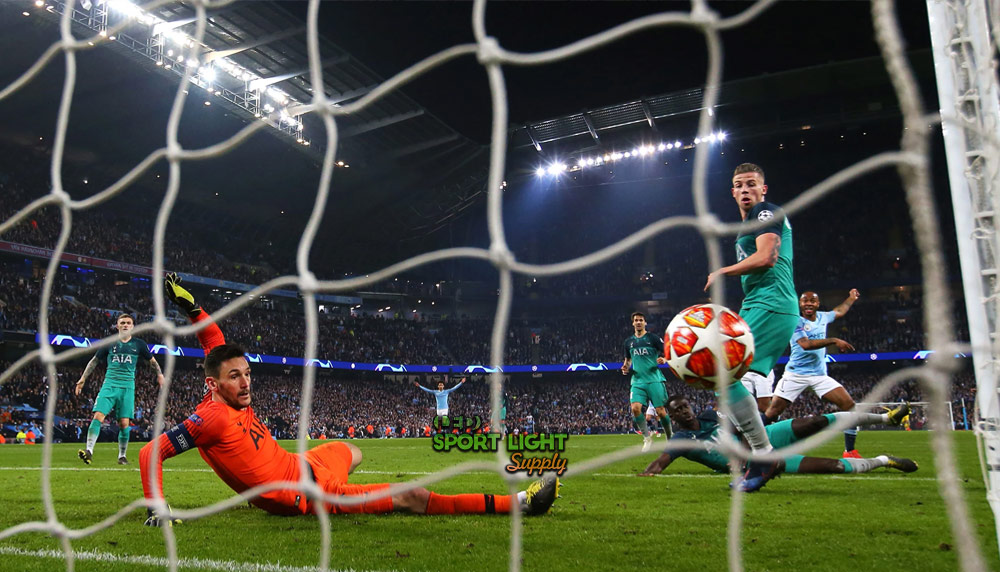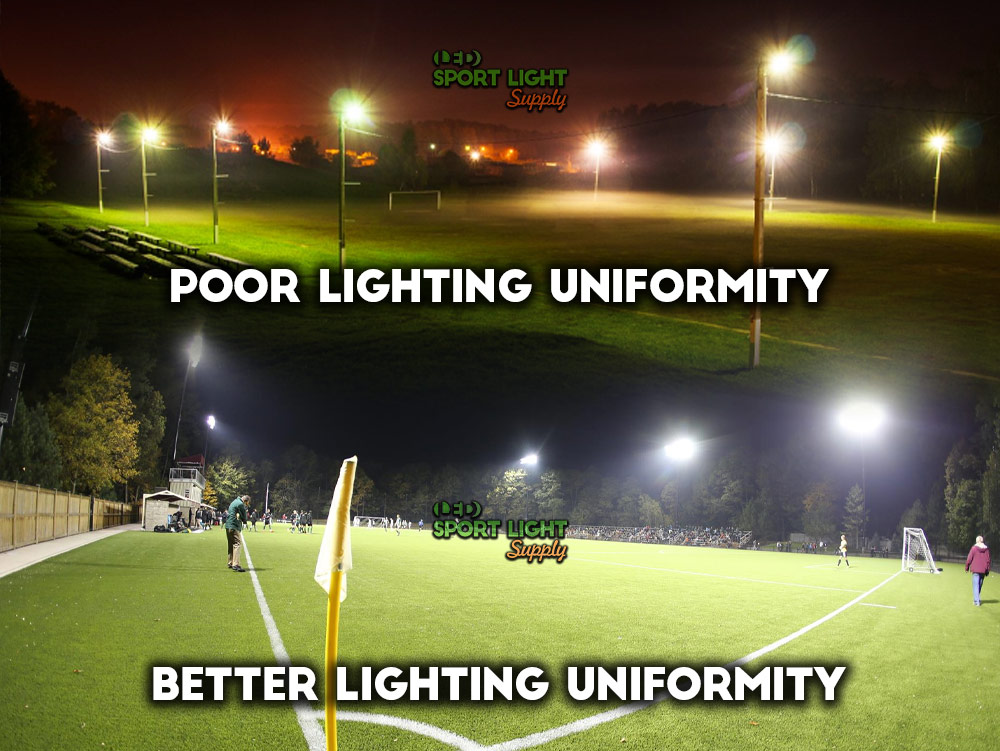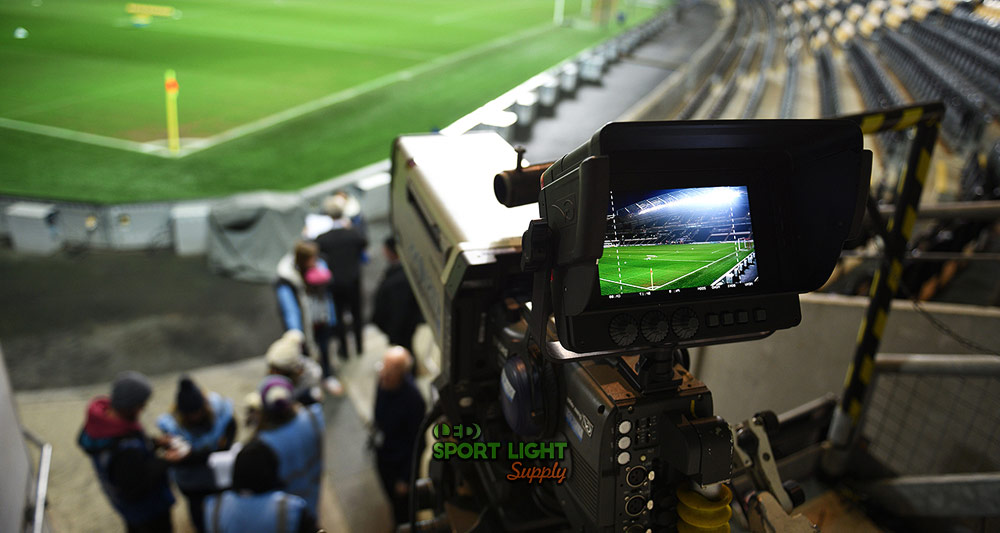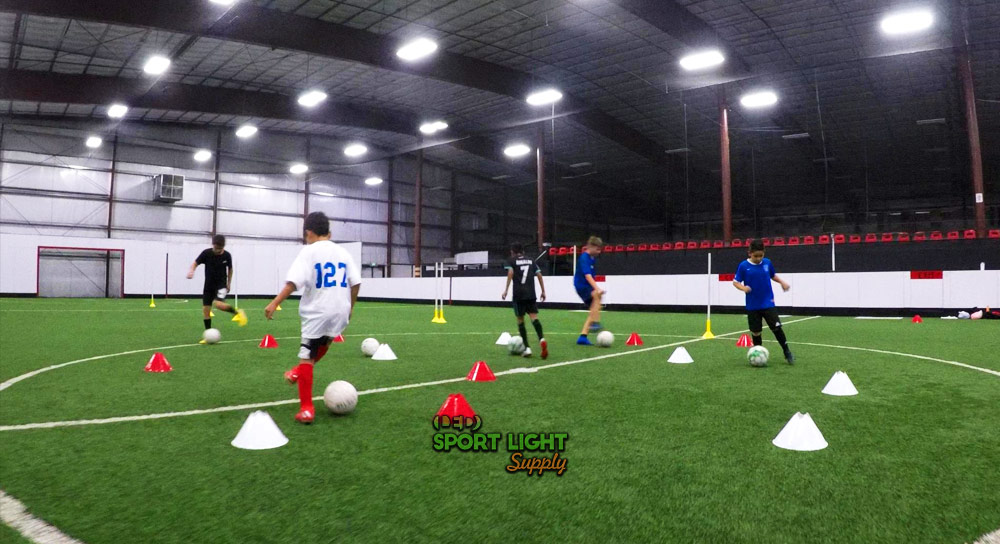Table of Contents
ToggleImproved Sports Players’ Vision
Bright Lighting
Bright lighting is essential in sports facilities as it closely mimics the intensity of natural sunlight, which is critical for enhancing the clarity of minute details on the field. Unlike standard office lighting, which is designed for general tasks and comfort, sports lighting must cater to the specific needs of athletic performance.
By providing illumination that approaches the brightness of natural daylight, sports lighting enhances athletes’ ability to see fine details, react swiftly, and maintain focus. This increased brightness helps in distinguishing small movements and subtle changes in the playing environment, contributing to both safety and competitive performance. Effective sports lighting ensures that players have the best possible visual conditions, allowing them to perform at their highest level.

Uniform Lighting
Uniform lighting across a playing field is crucial for ensuring consistent visibility and performance. Natural sunlight often results in varying light levels and shadows that can obscure important details and disrupt players’ focus. By employing uniform lighting, the entire field receives even illumination, which reduces the potential for shadows and dark spots that could hinder players’ ability to see the ball or other players clearly.
This consistency in lighting helps athletes track fast-moving objects and make precise movements without the distraction of uneven light. Uniform lighting not only enhances visibility but also improves the overall playing experience by providing a stable and predictable visual environment, essential for maintaining high performance in competitive sports.

High CRI
The Color Rendering Index (CRI) is a critical factor in sports lighting, as it measures how accurately light renders colors compared to natural light. A high CRI is essential for achieving true-to-life color perception, which is vital for both players and spectators. Lighting with a high CRI enhances the contrast between different colors and textures, making objects on the field more distinct and easier to identify. This is particularly important in sports where precise color differentiation can impact performance, such as in distinguishing between the ball and the playing surface.
High CRI lighting reduces glare, which can otherwise cause visual discomfort and hinder performance. By providing accurate color rendering, high CRI lighting ensures that athletes can see the field and their surroundings clearly, improving their ability to make quick, informed decisions.
Flicker-Free Lighting
Flicker-free lighting is a significant advantage in modern LED sports lighting systems. While all light sources can exhibit some degree of flicker, LED lights are designed to minimize this effect to an extent that it is imperceptible to the human eye. Flicker can be problematic in sports environments, as it may lead to visual discomfort and affect both players and spectators.
In high-speed sports where quick reactions are crucial, flicker-free lighting ensures a stable and consistent light output, reducing potential distractions and visual strain.
Furthermore, this feature is beneficial for television broadcasts and high-speed cameras, as flicker-free lighting prevents distortions in footage and ensures a clear and stable image. The absence of flicker contributes to a more comfortable and effective visual experience for everyone involved.

Shadowless Lighting
Shadowless lighting is achieved by providing illumination from multiple angles, ensuring that shadows are minimized or eliminated entirely. This approach is essential for sports facilities where clear visibility is crucial for gameplay. Shadows can obscure players, the ball, or other critical elements on the field, potentially affecting performance and fairness.
By strategically positioning lights around the field, sports lighting systems create an even distribution of light that prevents shadows from forming. This comprehensive lighting approach ensures that all areas of the playing surface are well-lit, allowing players to see clearly from any position on the field. Shadowless lighting enhances the overall visibility and safety of the playing environment, contributing to a better playing experience and more accurate gameplay.
Lux Light Levels
Lux light levels measure the intensity of light available for visual tasks, and they play a crucial role in determining the adequacy of sports lighting. Higher lux levels are often required for sports activities to ensure that the playing surface is illuminated sufficiently for detailed and dynamic movements.
The lux level needed varies depending on the specific sport and the level of competition. For instance, professional sports typically require higher lux levels compared to amateur or recreational levels to accommodate the increased speed and complexity of the game.
By providing appropriate lux levels, sports lighting ensures that players can see clearly and perform optimally, while also enhancing visual comfort and reducing eye strain. Proper lux levels are essential for creating a conducive environment for high-level performance and safe play.
Visible Light from All Angles
Eliminates Handicaps
Outdoor sports played under natural sunlight often face challenges due to the variable lighting conditions, such as shadows that can obscure critical details like the ball. Professional stadiums, however, use advanced sports lighting systems to overcome these issues. By providing consistent and bright illumination, these systems effectively eliminate shadows that could otherwise hinder players’ ability to see the ball or other key elements on the field. This comprehensive lighting approach ensures that no part of the playing surface is obscured, allowing athletes to perform at their best without the interference of natural lighting constraints.
Provides an Edge for Players
Lighting that covers the entire playing field from multiple angles offers significant advantages for players. With comprehensive illumination, athletes can better assess their surroundings, spot opportunities, and execute both offensive and defensive strategies with greater precision.
The availability of light from all directions ensures that players have full visibility of the field, helping them to identify advantageous positions and respond effectively to dynamic situations. This enhanced visibility contributes to improved performance and tactical advantage, allowing players to leverage the lighting to their benefit.
No Blind Spots
In professional sports, the presence of blind spots can significantly impact performance and fairness. Effective sports lighting systems are designed to eliminate these blind spots by ensuring that light is evenly distributed across the entire field. For instance, in sports like baseball, where outfield blind spots can be problematic, proper lighting placement is crucial.
By strategically positioning lights to cover all areas of the field, sports lighting systems prevent the formation of blind spots, providing a clear and unobstructed view for players. This reduction of blind spots ensures a more equitable and high-performing playing environment.
Color Temperature
Enhances a Sports Player’s Abilities
Color temperature plays a crucial role not only in visual clarity but also in influencing a player’s overall performance. Lighting with a high color temperature, which mimics the cooler hues of natural daylight, can positively impact players by boosting their alertness and energy levels. Exposure to light with higher Kelvin values has been shown to increase serotonin production in the body, which contributes to improved mood and mental sharpness.
This heightened state of alertness and energy can enhance a player’s ability to focus, make quick decisions, and perform at their peak. By creating an environment that replicates the natural sunlight spectrum, sports lighting can thus support and elevate athletic performance.
Excites the Crowd
Color temperature also affects the atmosphere of the stadium, influencing not only the players but also the spectators. High color temperature lighting can create a vibrant and dynamic visual experience, enhancing the excitement and engagement of the crowd. When fans experience a visually stimulating environment, their enthusiasm and support for the team are heightened.
This energetic crowd response can, in turn, boost the morale and performance of the players. The synergy between enthusiastic fans and well-designed lighting contributes to an electrifying atmosphere that benefits both the players on the field and the spectators in the stands.
Dimming
Dimmer Lights for Training

Dimming sports lighting plays a significant role in training sessions, where the focus is on building endurance and improving technique rather than high-intensity gameplay. Training environments benefit from reduced lighting levels, which can be adjusted using systems like DMA (Digital Multiplex) or DALI (Digital Addressable Lighting Interface). These dimmable lighting systems allow for a softer and more controlled illumination that reduces visual strain and creates a less intense environment. By lowering the light levels, athletes can engage in training sessions that are easier on both their muscles and their visual senses. This adjustment helps to create a more comfortable setting conducive to endurance building and skill development.
More Relaxed Environment
A dimmed lighting setup contributes to a more relaxed atmosphere during training sessions. Lower lighting levels help athletes to pace themselves and maintain focus without the pressure of full game intensity. This reduction in brightness can also have a calming effect, reducing stress and minimizing the risk of overexertion or injury. In sports where injuries can significantly impact a player’s season, creating a less stressful training environment is crucial. By slightly dimming the lights, athletes can train more effectively while minimizing physical and visual strain, leading to better preparation and reduced risk of injury.
Cooler Lighting
Historically, sports lighting systems, particularly those using incandescent or halogen bulbs, generated significant amounts of heat, creating an uncomfortable environment for both players and spectators. This excessive heat could lead to discomfort and sweating, particularly in enclosed arenas or gyms.
Modern LED lighting, however, produces minimal heat compared to older lighting technologies. The reduced heat output of LED lights not only enhances comfort by maintaining a cooler environment but also lowers the reliance on air conditioning systems. Consequently, sports facilities can benefit from reduced energy costs associated with cooling, while providing a more pleasant experience for everyone involved in the event.
LED Red Light Therapy for Sports Players
Photobiomodulation Therapy
Photobiomodulation therapy, often referred to as red light therapy, leverages the body’s ability to absorb light through specialized cells known as Cytochrome C. These cells contain proteins within their mitochondria that are highly receptive to red light wavelengths. The therapy harnesses this process to enhance cellular function by increasing the production of ATP (adenosine triphosphate) within the mitochondria. ATP is crucial for energy transfer and cellular repair. For athletes, this means that their muscles can recover more quickly from the stress and strain of training and competition. By incorporating red light therapy into their routines, athletes can support faster muscle repair and overall recovery.
Helps to Reduce Pain, Swelling, and Soreness
Red light therapy is beneficial not only for enhancing muscle recovery but also for alleviating pain, reducing swelling, and mitigating soreness. It is effective both before and after sporting events. Muscle fatigue can lead to pain and swelling, which red light therapy helps to counteract by increasing ATP levels and inhibiting the accumulation of metabolic byproducts.
Specifically, it addresses issues like muscle soreness caused by lactic acid build-up by promoting the formation of beneficial enzymes that help to clear these byproducts from the muscles. This therapeutic approach aids in preventing muscle damage and accelerates recovery, allowing athletes to train and perform at their best.
Improves Athletic Performance
Regular use of red light therapy can significantly enhance athletic performance by ensuring that muscles are well-recovered and primed for action. When incorporated into training regimens, this therapy can lead to improved endurance and sustained energy levels.
By facilitating quicker muscle repair and reducing recovery time, athletes can maintain a higher level of performance over extended periods. This sustained energy and reduced fatigue contribute to better overall athletic outcomes, allowing athletes to consistently reach their peak performance and remain competitive.
Helps Prevent Injury
Injury prevention is a critical aspect of an athlete’s training regimen, and red light therapy plays a valuable role in this regard. Effective muscle repair is essential for avoiding injuries, and red light therapy promotes rapid recovery by enhancing cellular repair processes.
Regular application of red light therapy helps muscles to recover more quickly and effectively, reducing the likelihood of injury. This proactive approach to muscle maintenance and recovery is why red light therapy is commonly used in high-level competitive sports. By supporting faster and more efficient healing, athletes can remain active and competitive, minimizing downtime due to muscle injuries.
Conclusion
Advanced sports lighting systems, including bright, uniform, and high-CRI lighting, are essential for optimizing athletes’ performance and safety. These technologies ensure clear visibility, reduce shadows, and enhance color accuracy, all of which contribute to improved gameplay and a better overall experience for both players and spectators. By incorporating features like flicker-free, shadowless illumination and appropriate lux levels, sports facilities can create ideal conditions for athletes to excel.
